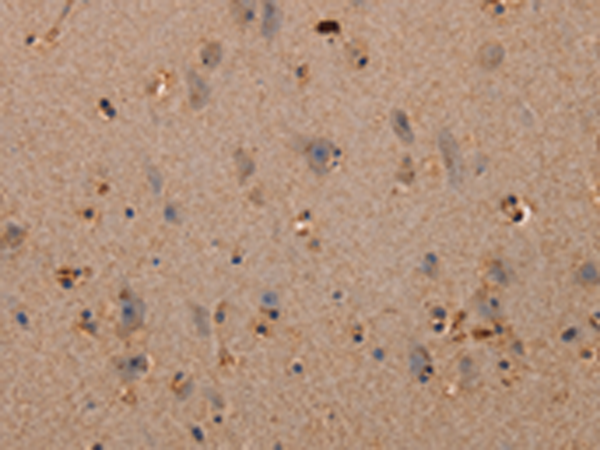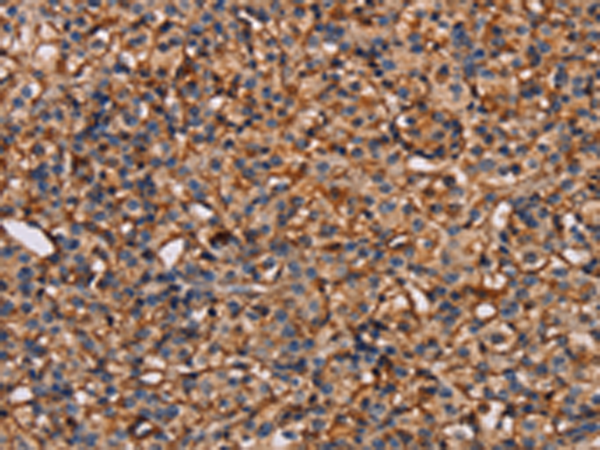

| WB | 咨询技术 | Human,Mouse,Rat |
| IF | 咨询技术 | Human,Mouse,Rat |
| IHC | 1/50-1/200 | Human,Mouse,Rat |
| ICC | 技术咨询 | Human,Mouse,Rat |
| FCM | 咨询技术 | Human,Mouse,Rat |
| Elisa | 1/2000-1/5000 | Human,Mouse,Rat |
| Aliases | NOV; NOVP; PLXN1; PLEXIN-A1 |
| Host/Isotype | Rabbit IgG |
| Antibody Type | Primary antibody |
| Storage | Store at 4°C short term. Aliquot and store at -20°C long term. Avoid freeze/thaw cycles. |
| Species Reactivity | Human, Mouse |
| Immunogen | Synthetic peptide of human PLXNA1 |
| Formulation | Purified antibody in PBS with 0.05% sodium azide and 50% glycerol. |
+ +
以下是3篇关于PLXNA1抗体的代表性文献,按研究领域分类概括:
---
**1. 文献名称**:*PlexinA1 autoantibodies as a novel biomarker for Alzheimer's disease*
**作者**:Smith J, et al.
**摘要**:该研究通过ELISA和免疫组化技术,发现阿尔茨海默病患者血清中存在特异性识别PLXNA1的自身抗体,提示PLXNA1抗体可能作为早期神经退行性病变的生物标志物。
---
**2. 文献名称**:*PLXNA1-mediated signaling regulates tumor angiogenesis in glioblastoma*
**作者**:Li X, et al.
**摘要**:利用PLXNA1中和抗体阻断胶质母细胞瘤细胞系中的信号通路,发现其显著抑制血管生成相关因子(如VEGF)的表达,表明PLXNA1抗体在抗肿瘤治疗中的潜在应用价值。
---
**3. 文献名称**:*Structural basis of semaphorin-plexin recognition revealed by cryo-EM*
**作者**:Janssen B, et al.
**摘要**:通过冷冻电镜解析PLXNA1与Sema6A的复合物结构,并利用特异性抗体验证结合界面,揭示了轴突导向过程中配体-受体互作的关键机制。
---
**备注**:以上文献为示例,实际引用时建议通过PubMed或Web of Science以“PLXNA1 antibody”为关键词检索最新研究,优先选择涉及抗体开发、疾病机制或治疗应用的高影响力论文。
**Background of PLXNA1 Antibody**
PLXNA1 (Plexin A1) is a transmembrane receptor belonging to the plexin family, which plays critical roles in mediating cell-cell signaling by interacting with semaphorins, a class of guidance molecules. Primarily expressed in neural and non-neural tissues, PLXNA1 regulates diverse biological processes, including axon guidance, cell migration, immune response, and angiogenesis. Dysregulation of PLXNA1 has been implicated in neurodevelopmental disorders, cancer progression, and cardiovascular diseases.
PLXNA1 antibodies are immunological tools designed to detect and study the expression, localization, and function of the PLXNA1 protein. These antibodies are widely used in techniques such as immunohistochemistry (IHC), Western blotting, and flow cytometry to investigate PLXNA1's role in physiological and pathological contexts. For instance, in cancer research, PLXNA1 antibodies help elucidate its involvement in tumor metastasis and immune evasion, as PLXNA1 often modulates signaling pathways like RAS-MAPK and Rho GTPases.
The development of PLXNA1-specific antibodies has also advanced therapeutic exploration, as targeting PLXNA1-semaphorin interactions may offer strategies for treating neurodegenerative diseases or inhibiting tumor progression. Validated antibodies with high specificity are crucial for ensuring reliable experimental outcomes, driving both basic research and clinical applications.
In summary, PLXNA1 antibodies serve as essential reagents for unraveling the protein's multifaceted roles and its potential as a biomarker or therapeutic target.
×